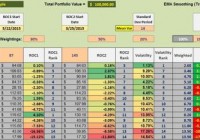Momentum Model Of ‘Swensen Six’ Portfolio Recommends 100% In Cash
Momentum Model called for move to cash back on August 10th. A three metric model is used to drive the momentum model. The “Swensen Six” portfolio covers six asset classes, depending on how asset class is defined. Example ETFs are provided to populate the recommended asset classes. David Swensen, in his book, Unconventional Success: A Fundamental Approach to Personal Investment , lays out what he calls “The Science of Portfolio Structure.” The following bullet points lay out the basic points of Swensen’s logic for constructing what I call the “Swensen Six” portfolio. Basic financial principles require the portfolio exhibit diversification and equity orientation. The “Swensen Six” is well diversified in that it covers the globe by using U.S. Equities (NYSEARCA: VTI ), Developed International Equities (NYSEARCA: VEA ), and Emerging Market Equities (NYSEARCA: VWO ). By equity orientation Swensen skews a portfolio toward stocks instead of bonds. The equity Exchange Traded Funds (ETFs) in the “Swensen Six” are: VTI, VEA, VWO, and VNQ . High expected return types of securities dominate the portfolio as 70% is allocated to equity investments. The specific percentages are listed below. Use six asset classes to provide portfolio diversification. Domestic equities comprise 30% of the portfolio or invest 30% in VTI. Swensen is not specific about the individual securities so I am recommending particular ETFs for each asset class. The percentages are Swensen recommendations. Determining what percentage to invest in what asset class is one of the most difficult decisions individual investors face when it comes to portfolio construction so Swensen’s percentage recommendations are most helpful. Developed international equities carry a recommendation of 10% so invest 10% in VEA. Originally, Swensen recommended 15% be allocated to developed international equities, but in a more recent paper lowered the percentage to 10%. One could stay with the original 15% recommendation. Emerging markets make up 10% of the portfolio so invest 10% in VWO. Originally, Swensen recommended 5% be assigned to emerging markets, but he later shifted 5% from developed international equities to emerging markets. One could stay with the original 5% recommendation. Domestic Real Estate makes up 20% of the total portfolio so invest 20% in VNQ. Another option is to invest 15% in VNQ and 5% in RWX , an international REIT ETF. This is my preference as it adds more diversification by adding a seventh asset class, International Real Estate. Investors wishing to keep life simple will stick to the “Swensen Six” rather than expand to include RWX. U.S. Treasury Bonds make up another 15% of the portfolio so invest 15% of the total in TLT . U.S. Treasury Inflation-Protected Securities is the last asset class and we invest 15% in TIP . In my Dashboards worksheet, I classify both TLT and TIP in the Bonds and Income asset class, but for purposes of following Swensen, I’ll break the two into separate asset classes. With only six ETFs, Swensen covers the globe so diversification is accomplished. The equity orientation is in place as 70% of the portfolio is tilted in that direction. Swensen provides interesting logic behind his recommendations. Two paragraphs from page 83 of his book state it very well so I quote below: “Investors achieve equity orientation by investing a preponderance of assets in the high-expected-return asset classes of domestic equity, foreign developed equity, emerging market equity, and real estate. The return-generating power of equity positions drives the results of long-term investment portfolios. Investors give up expected return to defend portfolios against unanticipated inflationary or deflationary economic conditions. U.S. Treasury Inflation-Protected Securities protect against inflation with certainty, while real estate holding guard against inflation with reasonable assurance. In the long run domestic equities add to the inflation-hedging characteristics of a portfolio, but in the short run domestic equities prove notoriously unreliable as inflation hedges.” This six ETF portfolio has an equity emphasis, provides some protection against inflation and is broadly diversified. By keeping these six assets in balance, the passive investor is well served. If you are a momentum style investor, what does the “Swensen Six” look like in the current market environment? Below is the ranking for these six ETFs and as readers can see, all monies are investing in SHY or cash. None of the critical ETFs are ranked above SHY. ETF Rankings of “Swensen Six”: The following ranking is built upon three metrics. Fifty percent (50%) of the weight is allocated to the performance of each ETF over the past 91 calendar days. Thirty percent (30%) of the weight is assigned to the performance over the most recent 182 calendar days and the final 20% is a volatility measurement where low volatility is highly valued. SHY is the cutoff or “circuit breaker” ETF. When the ETFs rank below SHY, as is currently the case, 100% of the portfolio is invested in SHY or cash. The portfolio is reviewed every 33 days as the ETFs are ranked again to see if any show up for potential investment. This portfolio has been in cash for nearly two months. (click to enlarge)
